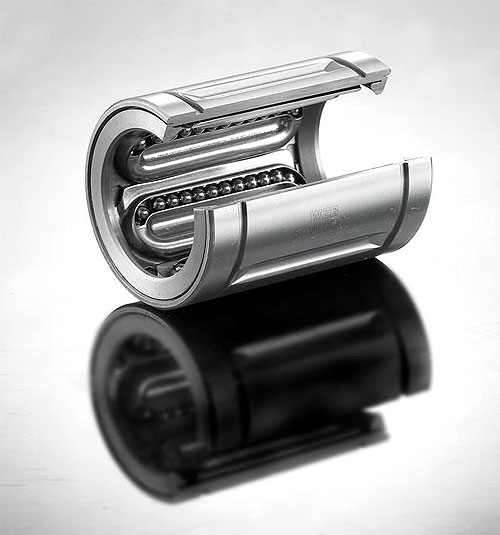Linear bearings generally use a pad, bushing, or roller system to carry a load on a rail that need not be a straight line. The rail can be most any length, although that dimension is limited by the actuator.
The durability of the bearing is determined by the load and required speed. Furthermore, rails can generally be any profile – simple flat surfaces, round polished rods, or complex profiles with polished ground surfaces on which balls or cylindrical rollers can ride. Hard (Rockwell 60) and ground bearing surfaces work best.
Further classifications might be by size. For instance, miniature linear bearings might work well moving a biologic slide sample just a few millimeters beneath a microscope lens while industrial-bearings on injection molding machines carry tooling of several tons.
Bushings provide possibly the simplest linear bearing. These thin-walled cylinders can be injection molded of proprietary polymers infused with a lubricant. An oil-infused bronze design, also cylindrical, rides on a polished round rod. This linear-bearing classification is often referred to as slides.
Purpose-built linear bearings are available for frequently encountered tasks, such as pull-out equipment drawers or storable work surfaces. These usually light-duty devices let polymer wheels or ball bearings ride on stamped or rolled steel rails. Telescoping arrangements allow designing pull-out equipment drawers into cantilevered positions while supporting up to 50 lb or more for maintenance.
Heavier loads are carried by linear guides that use re-circulating ball or roller bearings in rectangular mounting pads or slide units. These are so constructed that a loop of balls or cylindrical rollers cycles into and out of a load area along shafts at most any required load. Two, three, and four rails can work in unison to carry loads that exceed the rating of one rail.
The ball spline is a variation on this design. In it, the sliding unit is a cylinder with at least three and up to five circuits of re-circulating balls. There are dozens of cylindrical shapes to choose from. For instance, miniature designs are intended for instrumentation and pillow blocks are available when the rod must move while the rolling elements remain stationary. Some manufacturers boast of maintenance-free designs, which can mean several years between scheduled maintenance.
Long lengths can make use of a design in which the profile on a bearing-mounted wheel carries a V-shape that rides in a mating V on a rail edge. Such a design is less affected by debris and is said to operate without bellows and covers.
Nonlinear-linear bearings are also possible with permutations to the designs above. For example, so-called rectangular circuits have generously rounded corners, and oval rail circuits are possible by letting two sets of wheels or rollers ride in a groove on either side of the rail. Actuation can be provided by a timing belt mounted on the inside of the track.
Accessories for linear bearings include wipers that sweep a rail in front of a slide unit to keep dirt and debris from damaging rolling elements. Seals provide a similar function but are more intended to keep lubricant from seeping out of the bearing area.
A brief design checklist of considerations for a device requiring linear-motion bearings would include required rigidity, load, moment loads, and needed accuracy. Designers might also consider whether or not regular maintenance will be available, the possibility of vibration and how it could affect operations, and noise requirements. Of course, design is more complex than this. Manufacturers are likely to offer a range of shaft support shapes and materials, shaft material options such as particular carbon steels versus stainless, or even tubular shafts.



Leave a Reply
You must be logged in to post a comment.